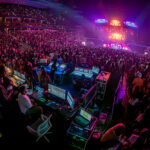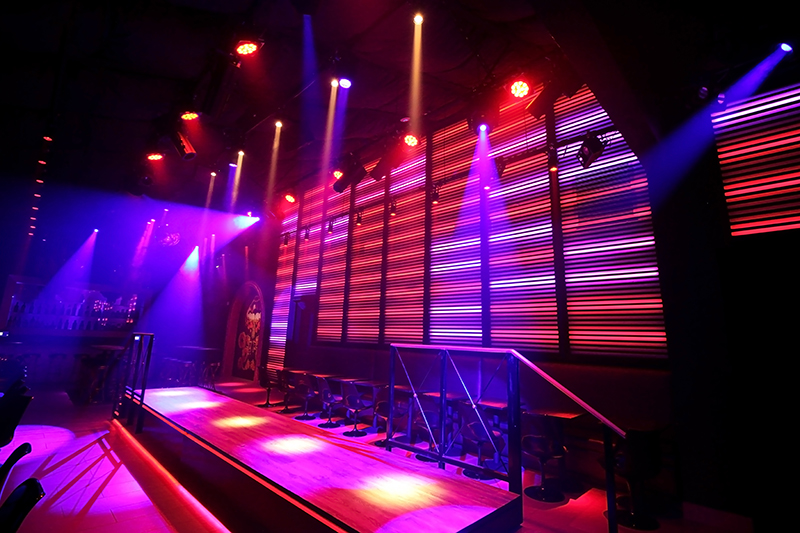
AsiaSF, the world famous entertainment landmark established 22 years ago in San Francisco, is more than a restaurant and bar. It is a cabaret restaurant dining experience that features Cal-Asian cuisine, handcrafted cocktails and live performances by the ladies of AsiaSF; performers and servers whom who are all transgender. Recently, a second location opened in Palm Springs, offering several indoor spaces with a full bar and dining room, plus an extensive outdoor event space known as The Sonoran.
The building, the site of the old Hacienda Cantina, opened the opportunity for the owners to better provide an immersive entertainment experience to facilitate the numerous spaces inside. The owners of the club called upon lighting designer Robert Sanders. This is Sanders second installation for the AsiaSF brand.
AsiaSF owners Larry Hashbarger and Aaron Nelson first approached Sanders two years ago to come up with a solution to replace an old fiber optic illuminator wall that replicated a traditional Japanese Shoji screen. A Shoji is a door, window or room divider used in traditional Japanese architecture consisting of translucent sheets on a lattice frame.
The old wall was not only limited by its inability to produce more than four basic colors, the technology in the ancient piece made refurbishment prohibitive. Sanders introduced CEO Hashbarger and CFO Nelson to the concept of LED. At first, upon seeing the small strips of RGB LED, the two were quite skeptical. The proof is in the pudding though; the owners were astonished by the new look, thereby launching a revolution in the way the original dining room could be presented and a solid business relationship was formed.
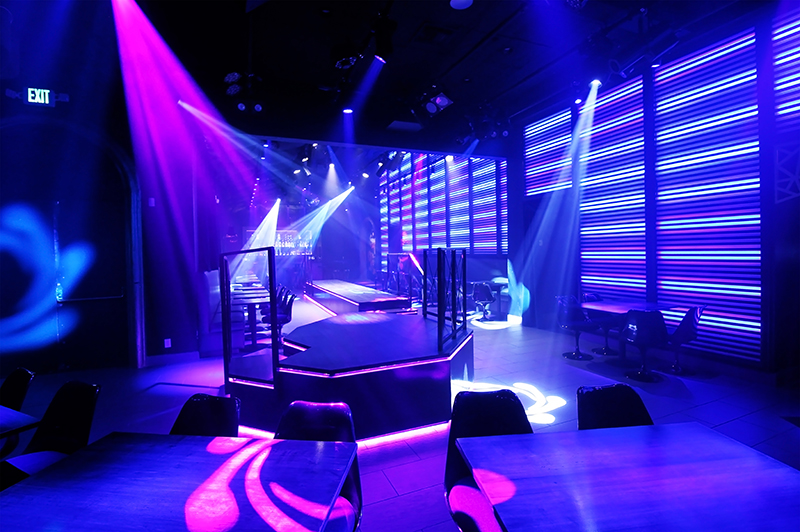
Overcoming Challenges
For the Palm Springs location, Sanders was invited to design the new space without having laid eyes on a single piece of information regarding just what the interior entailed. The owners flew him down for a walk through to again create an experience rather than just functional illumination in the club. Having seen his work at other venues, and after the successful reinterpretation he created in their San Francisco location they wanted him to be part of the new project.
Further information was limited. The only drawing available to Sanders was an overhead view of the space with lines but no dimensions. Working blind somewhat and not knowing ultimately where placement of some items would be, Sanders took running notes from afar as the building progressed.
An additional challenge was the fact that once he was able to work in the space he had exactly three weeks to complete the installation and programming. “This is one of those projects that hit so many little snags, it felt like a touring production moving from venue to venue and changing cities daily, adapting to the needs of the venue that day,” he says.
“One morning the stage was a long runway that blooms into an octagon shape thrust, and by end of day it was two separate pieces. I was kept on my toes! It made me dig deeper into how the space was going to flow and work with the interior design team to develop cost effective solutions as we were ultimately limited by an existing space — we couldn’t remove walls or raise the ceiling.”
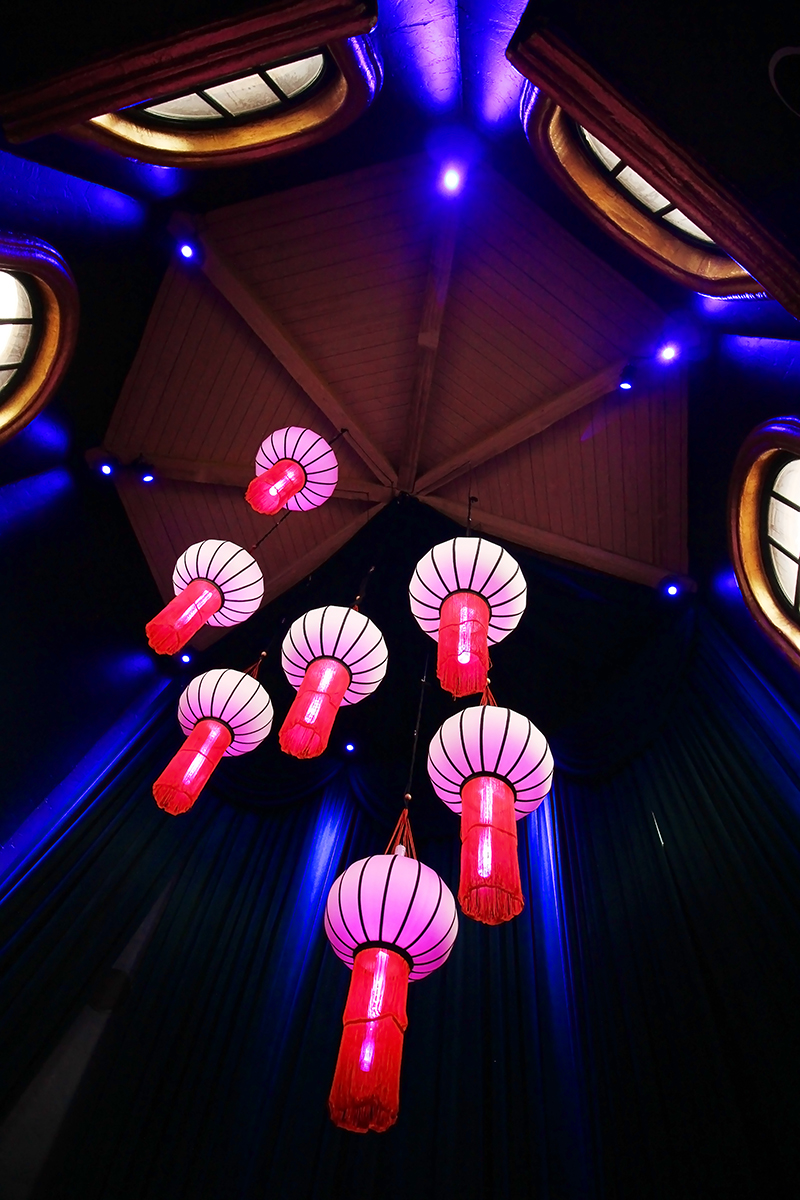
Enter JRLX
Both challenges were met with the help of his friend and business associate Jason Reberski, CEO of JRLX Inc., whom he had met almost a decade ago while searching on the Light-Network for a solution for a particular fixture. Reberski responded, which started a mutually beneficial relationship that has coincided with a true bond in friendship as well. “We’re like family,” says Sanders.
“Robert has been a longtime customer and friend of JRLX,” says Reberski, “In fact he ran the lighting at my wedding. We were excited to be involved in this large project.” For his part Reberski says of JRLX. “We provide sales, integration, and production touring support for a wide range of applications. In this case, we provided the sales support to Robert on the project as well as assistance with product specifications. Robert’s design and installation prowess resulted in an incredibly immersive finished product!”
The framework and main décor piece for the space is the Shoji wall that was custom designed and manufactured for the Palm Springs installation. The look is akin to hurricane shutters. Each panel is 4’ wide and the panels range from 6’ to 21’ high, totaling 2500’ ft in RGB strips. The LED strips had to be modified to offset and create different looks. The entire wall is almost a full universe of control.
The entertainment venue is made up of three different areas; dining area predominant, the lounge or waiting area, then behind the dining room is the nightclub, where the 14’ truss circle with a 40” mirror ball and several smaller 20’ mirror balls hang. Sanders specced a couple hundred American DJ fixtures ranging from LED pin spots highlighting dinner tables to ADJ12PX and 5PX HEX pars that light the stages.
The entryway to the venue features Asian Chinese Lantern mockups, hanging at various heights starting about 22’ high. Direction from the owners on this was simply, “It needs to look eye-catching.” Sanders’ search for a fixture that would not only illuminate as well as be eye catching while being able to change color resulted in an LED American DJ Pixel Tube 360 system. These one-meter long tubes have a master brain box for effects and colors.
“I was fortunate that I had such free rein for my fixture selections,” says Sanders. “It broadened my design not being limited to traditional public space treatments.” The only direction Sanders received was, “‘The nightclub has to have a large mirror ball and a circular truss, and it has to be as big as space will allow.’ They told me, ‘Make our new home a show space!’”
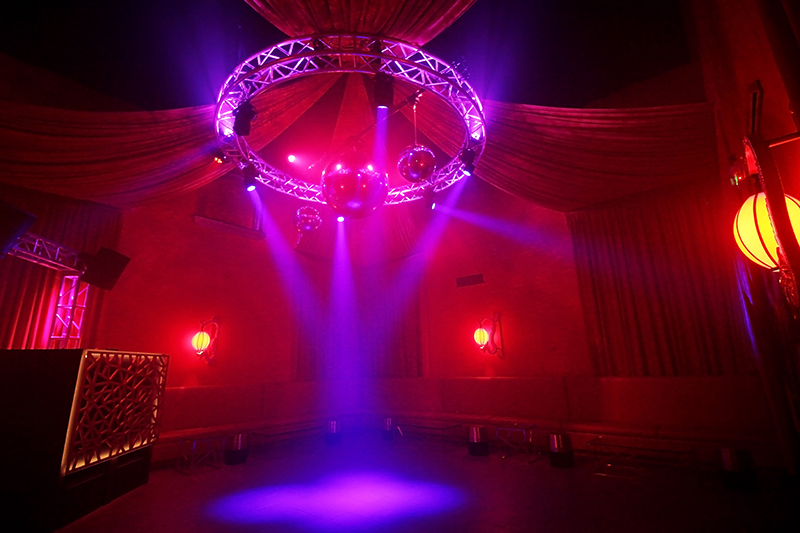
Control and Networking
For control, Sanders chose a High End Systems Rack Hog and a Hoglet, swayed by their mobility and space saving design. “The Rack Hog is easy to use and easy to learn; a work horse that handles the theatrical side of lighting as far as cueing goes and is able to build amazing complex effects flawlessly,” says Sanders. It controls nine universes actively and passively.
Macros trigger cue stacks for each performance which have anywhere from two to 60 cues. Run live, there are no audio triggers for timecode. “The choreography is always going to be the same for the ladies dance numbers essentially,” explains Sanders. “But I wanted the added flexibility to account for audience response and interaction.” Given the complex level of shows, Sanders programmed an additional complete busking page with on the fly cues and scenes.
Each room can run separately via Doug Fleenor Design Rerun (DFD) devices. The DFD ReRun’s allow the Lounge, Nightclub and Entry Chandelier to operate independently, and the looks can be chosen by the staff of the evening. The Road Hog has the capability of being master control to all areas should a color scheme of corporate branding be used or a similar need of that nature. Macro’s on the Hog system can “park and unpark” the universe for each of the rooms, allowing live control or takeover of the whole venue.
Everything is 100% LED with the majority brand of products coming from the American DJ line. “I’ve use American DJ in many installations before and the quality is fantastic,” says Sanders. “They hold up incredibly well.”
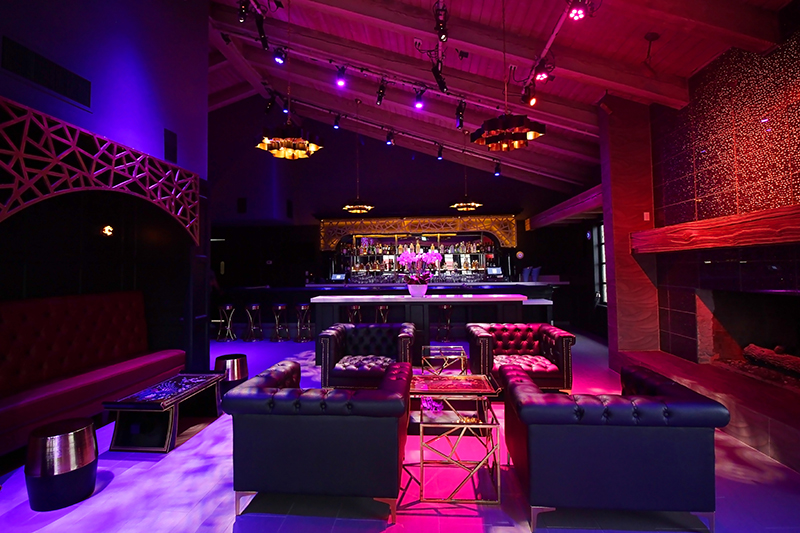
Related links: www.ragerlazer.com. www.jrlxinc.com
Crew
- Design and Installation: Robert Sanders
- Installation: Kevin Quintero, Nick Lopez
- LED Goddess/Installation: Michelle Ballestrasse
- AsiaSF Owners: Larry Hashbarger, founder and CEO; Aaron Nelson, president and COO
Gear
- 90x ADJ SaberSpot (80 RGBW model, 10 WW model)
- 22x ADJ 12PX Hex Par
- 20x ADJ 5PX Hex Par
- 14x ADJ Encore Profile
- 12x ADJ Ikon Profile WW
- 12x Chauvet R1X Spot
- 12x Chauvet R1X Wash
- 40″ and 20″ ADJ Mirror Balls
- 4x Antari Z380 Hazer
- 1x High End Systems RackHog
- 1x High End Systems Hoglet


